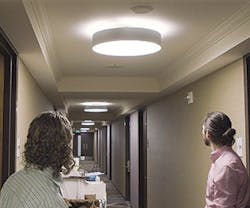Hilton Has Room to Improve with Plug Loads and LEDs
Hilton Union Square on San Francisco’s O’Farrell Street is the largest hotel on the West Coast with 1.8 million square feet, 46 stories and 1,919 guestrooms.
“We require our hotels to set annual targets for energy reduction. Each site has to implement improvement projects and use our corporate responsibility performance measurement system, which tracks over 200 sustainability metrics,” Verstraete explains. “We’ve seen over $550 million saved through efficiency projects and our company is the first international hospitality group to receive ISO 50001 certification for energy management.”
Lighting
Starting with individual rooms, the Whole Foods team noticed an absence of occupancy sensors for lighting. This could help the hotel conserve electricity if guests leave the room with the lights still on. With travelers needing to charge phones, laptops and other devices, controlled outlets could also help manage plug loads, recommends Daly.
The team also estimated that thousands of CFLs are being used for hallway illumination. “We acknowledge the challenge of retrofitting a building of this size, but the payback could be 5 to 7 years with LEDs,” stresses Tristam Coffin, Sustainable Facilities Coordinator.
Conference rooms, which account for over 140,000 square feet, could also benefit from occupancy sensors that communicate with a master schedule. While Whole Foods admired the work Hilton has done to use the latest LEDs, the team walked through a large ballroom that was lit but had no events in progress or scheduled.
Whole Foods Could Benefit From Better HVAC Controls
Facility Teams Get Swapped for Better Buildings Challenge
“We also saw a lot of plug loads and A/V equipment that were left on in the meeting spaces that could be shut down for additional savings,” observes Coffin.
“Overall there are significant opportunities to harvest lighting, add dimming controls or get rid of lights that are unnecessary,” Melton says.
Team Engagement
Whole Foods got to sneak into a housekeeper meeting where a department leader was emphasizing energy and sustainability practices using an upbeat tone. Hilton activates its employees to be more engaged with conservation because they are in an ideal position to drive cost efficiencies, explains Gaines.
“The excitement was really contagious at the pep rally as they talked about energy efficiency, water conversation and recycling,” says Coffin. “We’ve found that behavioral changes can make up 5-10% of efficiency measures. We can throw all of this technology at our problems, but without team member engagement, we’re never going to get there.”
HVAC
The building uses several 300- and 500-ton chillers in its plant. Although Hilton was commended for keeping up with maintenance, Daly suggested using a bypass option that goes directly to condenser water to achieve savings.
Walking through the kitchen, the team felt excess air being pulled through. “I can’t help but notice my curly locks blowing in the wind and there’s not a single vat on here for cooking,” quips Coffin.
For refrigeration, several curtain strips were missing and a door gasket was in disrepair. They also found a refrigerator door with the automatic closers set back, preventing doors from closing fully and creating a proper seal. “These could be a pretty easy and cheap fix for them that will immediately help to stop cold air from escaping and warm air from getting into the cooler,” says Melton. Once inside the walk-in units, the team brought up the possibility of raising the setpoints by a few degrees, which could save energy without sacrificing food safety.
Hilton also showed off how their automation system is synced to mobile phones, which allows them to change the settings on meeting room fans and turn chillers on or off. Mork finds that if an operator sees something but doesn’t have easy access to the equipment, they might defer taking care of the issue. A phone app makes their job easier.
About the Author
Jennie Morton
A former BUILDINGS editor, Jennie Morton is a freelance writer specializing in commercial architecture, IoT and proptech.
